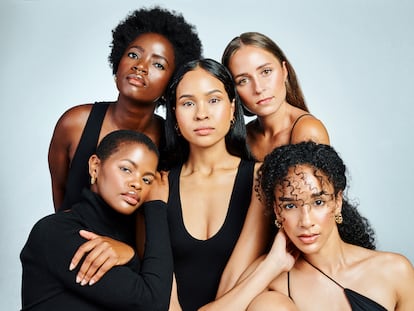Snatched jawlines: A well-defined jaw is the new aesthetic obsession
Low angles are the next selfie beauty standard, with people turning their heads to the side and placing the camera under their chin to flaunt an angular, very precise mandibular contour

What do Bella Hadid, Angelina Jolie and Katharine Hepburn have in common? A straight, well-defined, bony, perfectly angular jawline. The same thing that millions of selfies are pursuing with a somewhat unnatural pose: the head held up high, slightly tilted, exposing the entire jawline. The trend is all over social media: the hashtag #snatchedjawline has garnered more than 210 million views on TikTok.
Aesthetic medicine is no stranger to the phenomenon, and treatments that define the angle of the jaw abound. Dr Mar Mira, from the Mira Cueto Clinic in Madrid, Spain, warns about the dangers of getting carried away by an image set by social media: “Every day we see very young patients in the consultation who want to get the viral face of the moment. Before, it was very prominent cheekbones, and then came the totally unrealistic thick lips. Many of these trends alter the natural morphology that a proportionate face seeks. After the abuse of fillers, the thinness that comes with highly defined jawlines is now in fashion.”
The data is illuminating: Snapchat dysmorphia — a term that refers to coveting the looks we see on social media, which are often manipulated by unrealistic filters — is rising. Mira has carried out an extensive review of the scientific papers that have been published on this phenomenon, which has led to a 24% increase in the number of patients between 18 and 24 years of age who resort to aesthetic medicine to achieve the face they see online. “Although it mostly affects teenagers, it is reaching people over 35, 40 and 50. The youngest people seek to modify their features with thicker lips, a well-defined jawline and very prominent cheekbones. From the age of 40, people want to look younger and have the perfect skin that unreal filters create.”

Angular, bony jawlines take the “Instagram face” (a term coined by The New Yorker in 2019 to refer to the fillers that make the face swell) one step further. “This new standard of beauty once again revolves around thinness, in a system that promotes it as the only way to be healthy, but also as a synonym for success and validity. For this reason, many women spend energy, money and time trying to achieve a beauty ideal that affects their self-esteem,” says Estefanía Fernández, a nutritionist and dietician focused on the HAES (health at every size) approach.
In 2017, Instagrammer Michelle Liu brought a breath of fresh air to social media with the #chinning trend, which consisted in showing the double chin in a selfie. Her account now has more than 43 million followers. Still, the double chin has not yet succeeded in becoming the new canon of beauty. Low angles, however, are becoming the next selfie standard: if before people used to hold their phones above their heads to highlight their eyes and cheekbones, now they are turning their heads to the side and placing the camera under their chin to flaunt an outlined, bony, very precise jaw curvature. According to the Aesthetic Society, chin augmentation accounted for 29% of all aesthetic procedures in the United States in 2021.
These days, social media is full of exercises, tricks and treatments that promise to strengthen the chin, with the focus on highlighting the jawline. Here, experts analyze some of them.

Face taping to stretch the chin
Face taping is exactly what it sounds like. This technique achieves an immediate lifting effect, as if it were a face belt. The adhesive usually goes from the chin to the lower area of the ear, and then it is hidden with makeup. The oval is defined instantly, but the result is not always good. David Deibis, makeup artist at Perricone MD, questions the technique, because “it requires a lot of makeup to cover the adhesive tapes, causing a final look that is overdone and unnatural.”
Exercising the muscles with toning devices
TikTok is full of exercises in which people chew facial toning devices made of silicone or hard gum known as “jawline trainers.” Are they effective? “These are used to exercise the masseter muscle, which is the muscle we use for chewing. This way you can achieve greater projection of the jaw, but you have to be very careful not to damage your teeth,” says Mira. Dentist Víctor Cambra adds that “exercising the masseter muscles for aesthetic purposes can be dangerous to health. In addition to causing overload and contractures, exerting excessive force on the teeth can move or fracture them. Using these types of products can lead to serious dental and joint consequences.”
Exploring skin-tightening radiofrequency
Among the mini-invasive devices that promise to lift and sculpt the mandibular area is radiofrequency. “This technology manages to stimulate collagen production and tighten the skin in the facial oval,” says Dr Javier Capote from the Premium Marbella Clinic. One of the most famous radio frequency devices is Thermage FLX, which is very popular because celebrities like Jennifer Aniston, Oprah Winfrey and Gwyneth Paltrow have said that they have been undergoing this treatment once a year for more than a decade. “It still looks natural, and it is used to treat sagging, compact the tissue and outline the chin. It acts in the deep dermis, producing the contraction of old collagen and generating new, better collagen. All it takes is one session a year. More and more people are coming to our center looking for this technology to achieve an outlined jaw,” says Myriam Yébenes, CEO of the Maribel Yébenes centers. Another ally to treat this area is the Morpheus8 equipment, “a medical radiofrequency applied with microneedles that reduces double chin fat and strengthens the tissue,” explains aesthetic doctor Karen Valera.
Dermal fillers
Injectables can be used to project the chin without undergoing surgery. “Hyaluronic acid-based fillers are strategically injected along the jawline to create a more defined appearance. Collagen inducers like calcium hydroxyapatite can also be used with very good results to improve the projection of the chin,” says Capote. “We use MaiLi’s Extreme reticulated hyaluronic acid to sculpt the entire mandibular angle. This product has a great projection capacity and responds to the natural expressions of the face. After the session, slight bruising may appear. The results are maintained for a year,” explains aesthetic doctor Victoria Paéz.
Implants and liposuction: the surgical solution
When the aesthetic options do not yield the desired results, implants and permanent fat removal are the last resort. However, they are invasive techniques that are not risk-free. “From the age of 45, we perform many facelifts to redefine the mandibular angle and get rid of the double chin,” says Dr Javier de Benito. “Sometimes, after removing the fat to achieve natural traction throughout the cervicomental angle, if the chin lacks projection, we place a bone-shaped implant to achieve a complete redefinition. It does not require hospitalization and the recovery period usually lasts a week,” says de Benito.
Sign up for our weekly newsletter to get more English-language news coverage from EL PAÍS USA Edition
Tu suscripción se está usando en otro dispositivo
¿Quieres añadir otro usuario a tu suscripción?
Si continúas leyendo en este dispositivo, no se podrá leer en el otro.
FlechaTu suscripción se está usando en otro dispositivo y solo puedes acceder a EL PAÍS desde un dispositivo a la vez.
Si quieres compartir tu cuenta, cambia tu suscripción a la modalidad Premium, así podrás añadir otro usuario. Cada uno accederá con su propia cuenta de email, lo que os permitirá personalizar vuestra experiencia en EL PAÍS.
¿Tienes una suscripción de empresa? Accede aquí para contratar más cuentas.
En el caso de no saber quién está usando tu cuenta, te recomendamos cambiar tu contraseña aquí.
Si decides continuar compartiendo tu cuenta, este mensaje se mostrará en tu dispositivo y en el de la otra persona que está usando tu cuenta de forma indefinida, afectando a tu experiencia de lectura. Puedes consultar aquí los términos y condiciones de la suscripción digital.
More information
Archived In
Últimas noticias
Most viewed
- Reinhard Genzel, Nobel laureate in physics: ‘One-minute videos will never give you the truth’
- Oona Chaplin: ‘I told James Cameron that I was living in a treehouse and starting a permaculture project with a friend’
- Pablo Escobar’s hippos: A serious environmental problem, 40 years on
- Why we lost the habit of sleeping in two segments and how that changed our sense of time
- Chevy Chase, the beloved comedian who was a monster off camera: ‘Not everyone hated him, just the people who’ve worked with him’










































